

Torture in Star Wars
In The Force Awakens audiences are introduced to a new antagonist named Kylo Ren. There remains much to learn about Ren, but what is clearly known is that he is one evil guy. In the early minutes of the movie Ren wastes no time in murdering Lor San Tekka when he refuses to reveal where he’s hidden the map to Luke Skywalker. Still filled with rage, Kylo Ren shows no mercy when he orders Captain Phasma to indiscriminately eliminate all inhabitants of Tekka’s village, Tuanul. The masked dark sider then takes the captured Resistance pilot, Poe Dameron, to his Star Destroyer, the Finalizer where he hopes to learn the location of the map to Skywalker. When Poe proves resistant to a pain-inflicting interrogation chair, Kylo Ren decides to personally get the pilot talking. Ren, neither a Jedi or Sith, is gifted with the Force and uses his power to manipulate, torture and probe the minds of his captured enemies. In the end, Poe cannot resist the mind probe and has no choice but to give up the information Kylo Ren seeks. Thus, the First Order’s fateful hunt for BB-8 begins.
The villains of Star Wars have a long standing tradition of using torture to acquire the information they seek. In A New Hope, Princess Leia is subjected to an Imperial IT-O Interrogation Unit that features a needle that looks to be about six inches long. From dialogue exchanged later in the film, audiences learn that the interrogation droid was to “probe her mind.” Much like Rey in The Force Awakens, Leia resists the probe and refuses to give up the location of the hidden Rebel base.
In The Empire Strikes Back, Han is captured by the Empire and subjected to a torture device that causes a tremendous amount of pain. Unlike traditional torture, the Empire physically hurts Solo, but does so without any interrogation. It is later revealed that Han’s pain is merely being used by Darth Vader to lure Luke Skywalker to Cloud City via the Force.
Han is tortured at the hands of Darth Vader.
Kanan is tortured by the Inquisitor in Rebel Resolve.
In Return of the Jedi, a misbehaving "Gonk" droid is seen being tortured in Jabba’s Palace. It is never made clear in the film what the droid did that caused him to be tortured, but the end result was having its “feet” exposed to hot irons over and over again. As the scene cuts away, the droid can be heard screaming out in pain, “No, No, No!”
In Star Wars: Rebels, Kanan Jarrus is captured and tortured at the hands of Agent Kallus and the evil Grand Inquisitor. In true Jedi form, Kanan resists the Inquisitor's torture and does not give up the locations of hidden Rebel cells or the true identity of the mysterious "Fulcrum."
Torture in Our World
Torture is the act of inflicting psychological or physical pain in an effort to gain information or force someone to engage in a specific action. A long standing, but unfortunate part of human history, the use of torture can be traced back to many of our ancient civilizations. Although most torture methods are intended only to hurt or damage a person, some methods intentionally result in death, but the means cause an intentionally slow and painful demise.
Historically, people are tortured for a variety of reasons, but they commonly include:
Interrogation – A captive is tortured in an effort to retrieve significant information they are believed to possess.
Punishment – An individual is tortured for engaging in activities or behaviors deemed illegal.
Re-education – Torture is used in an effort to force someone to behave in a desired way.
Deterrence – People are sometimes tortured, often publically, in an effort to deter or scare others from engaging in certain, illegal activities.
Sadism – A person may be tortured simply because an individual of power enjoys inflicting pain or watching people suffer.
Most nations outlawed torture in the years following World War II. Although international law prohibits torture, it remains controversial due to its continued use in many countries. Some nations currently practice torture covertly or challenge the limits of the law by practicing “enhanced interrogation techniques” such as the controversial method of waterboarding.
Torture in Ancient Greece and Rome
During the time of Ancient Greece and the Roman Republic, torture was reserved only for slaves. In fact, a slave’s testimony was only trusted if it was obtained through torture. It was commonly believed that a slave could not voluntarily reveal the truth. Later, in the days of the Roman Empire, torture was extended to include most of the lower class. Historically, torture was often been performed publically. The dual purpose of this is to humiliate the victim while also sending a message of deterrence to the spectators.

The Brazen Bull
A popular torture device in the days of the Ancient Greeks was the Brazen Bull. In this method, a life-size bull was sculpted from bronze and an access door was placed on one side. The condemned person would be placed inside and then a raging fire would be started beneath the Brazen Bull. Inside, the poor soul would slowly cook to death as the Bull gradually warmed up. As if that were not enough, the Bull’s designer, Perillos, acoustically engineered tubes inside so that the person’s screams would, in fact, resemble the sound of a bull.
A common and well known torture method used by the Romans was crucifixion. The condemned person would be nailed or tied to a wooden cross that would then be raised to stand upright. With gravity pulling the body downward and the arms being held in a higher position, the victim would find breathing extremely difficult. Over and over again, the person would have to pull their body upright to take a breath. Sometimes surviving for days, the body would eventually fatigue and, unable to draw breath, the person would suffocate. Crucifixion is one of the most widely known ancient forms of torture due to its close ties to Christianity and the death of Jesus.
Torture in the Middle Ages
Perhaps the most notorious era of torture occurred during the Middle Ages. Although many torture methods carried over from antiquity, the medieval period saw the development of even more horrific devices for tormenting people.
During this time, a popular torture and execution method was immersing a condemned person in boiling liquid such as water or oil. Victims were commonly placed head first into the boiling liquid, but more sadistic rulers would only bring the liquid to a boil once the person had been placed inside the cauldron.
Dunking a person in water was also a typical method of extracting a confession or valuable information. Using ropes and pulleys, a person would be dangled over a stream or river and then repeatedly submerged. The victim would be raised when they were near passing out or to gain a confession or information. Dunking was also popular during the days of the infamous witch hunts of the 16th and 17th centuries.
One of the most well-known of all torture devices is the rack. This device consisted of a rectangular wooden frame with rollers at both ends. The victim would be laid on the rack and their feet and arms would be bound to the rollers. Throughout the torture, a ratchet system would be used to tighten the rollers, slowly increasing tension on the person’s arms and legs. With each turn of the ratchet, the person would be in more and more pain until finally, the muscles, tendons, or bones would finally give and snap or break. Although injuries caused by the rack could result in death, this device was primarily used to create extensive pain to the point of a quick confession. Of course, confession did not necessarily free you. The reward for confessing was typically a more instant and less painful death.
Torture in the 20th Century
In spite of a global increase in human rights, torture was still commonly used throughout much of the 20th century. Torturous activities were employed by totalitarian regimes such as Mussolini’s Fascists, Hitler’s Nazis, and Stalin’s Soviets. Following World War II, many nations rejected torture, but Cold War conflicts often forced such policies aside. During the Vietnam War, for example, both the United States and North Vietnamese engaged in torture in an effort to acquire valuable military intelligence.
Torture Today
Despite being illegal according to international law, torture unfortunately continues in our world today. While some countries openly torture people as part of their judicial system, most nations that do so, practice torture in secret. Others create controversy by bending the rules to engage in torture-like actions. In recent years, the United States and its allies have been criticized for using “enhanced interrogation techniques” on many captured terrorists during the War on Terror. Such tactics include waterboarding where a person is repeatedly subjected to a sense of drowning.
Although torture continues to be practiced across the globe, great strides have been made in human rights since the time of the Middle Ages. Today, most democratic nations provide fair trials to accused people and even when found guilty, reject “cruel and unusual punishments” upon their people. There are also numerous organizations like Amnesty International and Human Rights Watch which work tirelessly to investigate reports of torture and to hold those who inflict unjust harm accountable for their actions. In the future, torture will continue to be challenged and redefined, but torturous practices will likely never completely go away. As long as tyrants, governments and other groups demand information or change, people will most certainly be subjected to unfair treatment at the hands of their captors or oppressors.
Kylo Ren, Interrogation Droid, Poe Dameron, Rey, Princess Leia, Gonk Droid, Kanan Jarrus, The Grand Inquisitor
- Star Wars Recalls an Iconic World War II Photo and the Cold War
- Democracy versus Dictatorship
- Imagery of the Third Reich in the First Order
- Corruption of Powerful Symbols
- Order 66 and the Night of the Long Knives
- Star Wars & the Dam Busters
- What if Hitler Had Developed Nuclear Weapons?
- Wookieepedia - Torture in Star Wars
- Medieval Torture (Contains Graphic Content)
- Human Rights Watch on Torture
- IRCT - Torture
- Amnesty International - Torture
- The Guardian - Articles on Torture
First posted on: January 1, 2016 by Wes Dodgens






